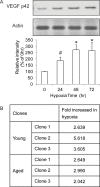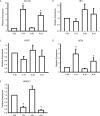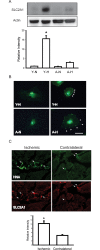Genetic profiling of young and aged endothelial progenitor cells in hypoxia
- PMID: 29708992
- PMCID: PMC5927426
- DOI: 10.1371/journal.pone.0196572
Genetic profiling of young and aged endothelial progenitor cells in hypoxia
Abstract
Age is a major risk factor for diseases caused by ischemic hypoxia, such as stroke and coronary artery disease. Endothelial progenitor cells (EPCs) are the major cells respond to ischemic hypoxia through angiogenesis and vascular remodeling. However, the effect of aging on EPCs and their responses to hypoxia are not well understood. CD34+ EPCs were isolated from healthy volunteers and aged by replicative senescence, which was to passage cells until their doubling time was twice as long as the original cells. Young and aged CD34+ EPCs were exposed to a hypoxic environment (1% oxygen for 48hrs) and their gene expression profiles were evaluated using gene expression array. Gene array results were confirmed using quantitative polymerase chain reaction, Western blotting, and BALB/c female athymic nude mice hindlimb ischemia model. We identified 115 differentially expressed genes in young CD34+ EPCs, 54 differentially expressed genes in aged CD34+ EPCs, and 25 common genes between normoxia and hypoxia groups. Among them, the expression of solute carrier family 2 (facilitated glucose transporter), member 1 (SLC2A1) increased the most by hypoxia in young cells. Gene set enrichment analysis indicated the pathways affected by aging and hypoxia most, including genes "response to oxygen levels" in young EPCs and genes involved "chondroitin sulfate metabolic process" in aged cells. Our study results indicate the key factors that contribute to the effects of aging on response to hypoxia in CD34+ EPCs. With the potential applications of EPCs in cardiovascular and other diseases, our study also provides insight on the impact of ex vivo expansion might have on EPCs.
Conflict of interest statement
Figures




Similar articles
-
Statins, HMG-CoA Reductase Inhibitors, Improve Neovascularization by Increasing the Expression Density of CXCR4 in Endothelial Progenitor Cells.PLoS One. 2015 Aug 26;10(8):e0136405. doi: 10.1371/journal.pone.0136405. eCollection 2015. PLoS One. 2015. PMID: 26309120 Free PMC article.
-
Hypoxia inhibits cellular senescence to restore the therapeutic potential of old human endothelial progenitor cells via the hypoxia-inducible factor-1α-TWIST-p21 axis.Arterioscler Thromb Vasc Biol. 2013 Oct;33(10):2407-14. doi: 10.1161/ATVBAHA.113.301931. Epub 2013 Aug 8. Arterioscler Thromb Vasc Biol. 2013. PMID: 23928864
-
CD34 hybrid cells promote endothelial colony-forming cell bioactivity and therapeutic potential for ischemic diseases.Arterioscler Thromb Vasc Biol. 2013 Jul;33(7):1622-34. doi: 10.1161/ATVBAHA.112.301052. Epub 2013 May 2. Arterioscler Thromb Vasc Biol. 2013. PMID: 23640491
-
Endothelial Progenitor Cells as Molecular Targets in Vascular Senescence and Repair.Curr Stem Cell Res Ther. 2018;13(6):438-446. doi: 10.2174/1574888X13666180502100620. Curr Stem Cell Res Ther. 2018. PMID: 29732993 Review.
-
Endothelial progenitor cells in age-related vascular remodeling.Cell Transplant. 2018 May;27(5):786-795. doi: 10.1177/0963689718779345. Epub 2018 Jun 8. Cell Transplant. 2018. PMID: 29882417 Free PMC article. Review.
Cited by
-
HOX genes in stem cells: Maintaining cellular identity and regulation of differentiation.Front Cell Dev Biol. 2022 Sep 13;10:1002909. doi: 10.3389/fcell.2022.1002909. eCollection 2022. Front Cell Dev Biol. 2022. PMID: 36176275 Free PMC article. Review.
-
Where Metabolism Meets Senescence: Focus on Endothelial Cells.Front Physiol. 2019 Dec 18;10:1523. doi: 10.3389/fphys.2019.01523. eCollection 2019. Front Physiol. 2019. PMID: 31920721 Free PMC article. Review.
-
Differential Expression of Myogenic and Calcium Signaling-Related Genes in Broilers Affected With White Striping.Front Physiol. 2021 Jul 26;12:712464. doi: 10.3389/fphys.2021.712464. eCollection 2021. Front Physiol. 2021. PMID: 34381378 Free PMC article.
-
Transplantation of CD34+ cells for myocardial ischemia.World J Transplant. 2021 May 18;11(5):138-146. doi: 10.5500/wjt.v11.i5.138. World J Transplant. 2021. PMID: 34046316 Free PMC article. Review.
-
Unlocking mammalian regeneration through hypoxia inducible factor one alpha signaling.Biomaterials. 2021 Feb;269:120646. doi: 10.1016/j.biomaterials.2020.120646. Epub 2021 Jan 9. Biomaterials. 2021. PMID: 33493769 Free PMC article. Review.
References
-
- Charles ST, Carstensen LL (2010) Social and emotional aging. Annu Rev Psychol 61: 383–409. doi: 10.1146/annurev.psych.093008.100448 - DOI - PMC - PubMed
-
- Kelly TN, Bazzano LA, Fonseca VA, Thethi TK, Reynolds K, He J (2009) Systematic review: glucose control and cardiovascular disease in type 2 diabetes. Ann Intern Med 151: 394–403. - PubMed
-
- Kim SY, Guevara JP, Kim KM, Choi HK, Heitjan DF, Albert DA (2009) Hyperuricemia and risk of stroke: a systematic review and meta-analysis. Arthritis Rheum 61: 885–892. doi: 10.1002/art.24612 - DOI - PMC - PubMed
-
- Kuper H, Nicholson A, Kivimaki M, Aitsi-Selmi A, Cavalleri G, Deanfield JE, et al. (2009) Evaluating the causal relevance of diverse risk markers: horizontal systematic review. BMJ 339: b4265 doi: 10.1136/bmj.b4265 - DOI - PMC - PubMed
-
- Milicevic Z, Raz I, Beattie SD, Campaigne BN, Sarwat S, Gromniak E, et al. (2008) Natural history of cardiovascular disease in patients with diabetes: role of hyperglycemia. Diabetes Care 31 Suppl 2: S155–160. - PubMed
Publication types
MeSH terms
Substances
LinkOut - more resources
Full Text Sources
Other Literature Sources
Miscellaneous

